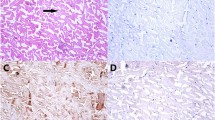Abstract
Purpose
Removal of the meniscus leads to progressive degenerative arthritis of the knee on a long-term basis; therefore, meniscal allograft transplantation has been proposed as an alternative to meniscectomy. Preservation methods are required to build up operational stocks and to provide living grafts of a practical size at the right time for patients. Methods for meniscus preservation have been published, and relevant literature confirms that using standard cryopreservation, the chondrocyte survival in situ is inadequate and extremely variable and the cryoinjury mechanisms are not completely established. The aim of the present study is to further investigate possible cellular injury caused by cryopreservation by analysing apoptosis and ultrastructural damage to menisci.
Methods
Seven human menisci that were cryopreserved by standard method were used. All tissue samples were processed simultaneously for routine light microscopy, scanning and transmission electron microscopy as well as apoptosis assessment by the use of ISOL method.
Results
With respect to cellularity, significant differences (P < 0.05) between the fresh (14.6 ± 3.5) (mean ± SD) and cryopreserved menisci (9.2 ± 2.8) (mean ± SD) were observed. Apoptosis using ISOL method was observed in fibrochondrocytes of fresh and cryopreserved menisci. The quantitative analysis revealed significant differences (P < 0.05) between fresh meniscus samples, where the apoptotic index was 0.8 ± 2.3% (mean ± SD), and cryopreserved meniscus samples, where this index was 50 ± 18.1% (mean ± SD).
Conclusion
The results suggest that apoptosis occurs during meniscus cryopreservation. The major findings of this study are cellular damage in meniscus cryopreservation suggesting apoptosis-mediated cell loss. The findings reported herein encourage to further investigations in preservation procedures to enhance maximum long-term clinical survival.






Similar content being viewed by others
References
Acosta CA, Izal I, Ripalda P et al (2007) Cell viability and protein composition in cryopreserved cartilage. Clin Orthop Related Res 460:234–239
Alexis C, Dang MD, Hubert T et al (2009) Chondrocyte apoptosis after simulated intraarticular fracture. Clin Orthop Relat Res 467:1877–1884
Baust JM, van Buskirk R, Baust JG (2000) Cell viability improves following inhibition of cryopreservation induced apoptosis. In vitro Cell Dev Biol 36:262–270
Cummings MC, Winterford CM, Walker NI (1997) Apoptosis. Am J Surg Pathol 21:88–101
Didenko VV, Hornsby PJ (1996) Presence of double-strand breaks with single-base 3′ overhangs in cells undergoing apoptosis but not necrosis. J Cell Biol 135:1369–1376
Frankfurt OS, Krishen A (2001) Identification of apoptotic cells by formamide-induced DNA denaturation in condensed chromatin. J Histochem Cytochem 49:369–378
Gelber PE, Gonzalez G, Torres R et al (2009) Cryopreservation does not alter the ultrastructure of the meniscus. Knee Surg Sports Traumatol Arthrosc 17:639–644
Hilbert SL, Luna RE, Zhang J et al (1999) Allograft heart valves: the role of apoptosis-mediated cell loss. J Thorac Cardiovasc Surg 117:454–462
Hommen JP, Applegate GR, del Pizzo W (2007) Meniscus allograft transplantation: ten year results of cryopreserved allografts. Arthroscopy 23:388–393
Lewis PB, Williams JM, Hallab N et al (2008) Multiple freeze-thaw cycled meniscal allograft tissue: a biomechanical, biochemical, and histologic analysis. J Orthop Res 49–55
Malinin TJ, Wagner JL, Piña JC et al (1985) Hypothermic storage and cryopreservation of cartilage. Clin Orthop Rel Res 197:15
McDermott ID (2010) What tissue bankers should know about the use of allograft meniscus in orthopaedics. Cell Tissue Bank 11:75–85
Noyes FR, Barber-Westin SD, Rankin M (2004) Meniscus transplantation in symptomatic patients less than fifty years old. J Bone Joint Surg Am 86:1392–1404
Pegg DE, Wusteman MC, Wang L (2006) Cryopreservation of articular cartilage. Part 1: conventional cryopreservation methods. Cryobiology 52:335–346
Pegg DE, Wang L, Vaughan D, Hunt C (2006) Cryopreservation of articular cartilage. Part 2: mechanisms of cryoinjury. Cryobiology 52:347–359
Pegg DE, Wang L, Vaughan D (2006) Cryopreservation of articular cartilage. Part 3: the liquidus-tracking method. Cryobiology 52:360–368
Peters G, Wirth CJ (2003) The current state of meniscal allograft transplantation and replacement. Knee 10:19–31
Rendal ME, Maneiro E, Rodriguez M et al (2001) Effect of cryopreservation on human articular chondrocyte viability, proliferation and collagen expression. Cryobiology 41:2–10
Rijk PC (2004) Meniscal allograft transplantation—Part I: background, results, graft selection and preservation, and surgical considerations. Arthroscopy 20:728–743
Schachar NS, Novak K, Hurting MB et al (1999) Transplantation of cryopreserved osteochondral dowel allografts for repair of focal articular defects in an ovine model. J Orthop Res 17:909–920
Stone KR, Adelson WS, Pelsis JR et al (2010) Long-term survival of consurrent meniscus allograft transplantation and repair of the articular cartilage: a prospective 2- to 12-year follow-up report. J Bone Joint Surg Br 92:941–948
Tomford WW, Springfield DS, Mankin HJ (1992) Fresh and frozen articular cartilage allografts. Orthopedics 15:1183–1188
Villalba R, Peña J, Luque E et al (2001) Characterization of ultrastructural damage of valves cryopreserved under standard conditions. Cryobiology 43:81–84
Author information
Authors and Affiliations
Corresponding author
Rights and permissions
About this article
Cite this article
Villalba, R., Peña, J., Navarro, P. et al. Cryopreservation increases apoptosis in human menisci. Knee Surg Sports Traumatol Arthrosc 20, 298–303 (2012). https://doi.org/10.1007/s00167-011-1622-x
Received:
Accepted:
Published:
Issue Date:
DOI: https://doi.org/10.1007/s00167-011-1622-x




